Archives
now browsing by author
Legal Aid Services at Community Center, Monday, June 30

LEGAL AID SERVICES OF OKLAHOMA, INC.
We will be at the Delaware Community Center soon to answer yoiur questions and to help if you have legal issues.
Legal Aid Services is a Non-Profit Organization.
Legal Aid provides free civil legal services to eligible low-income Oklahomans and Seniors 60+
Legal Aid offers our Seniors free Estate Planning
We prepare Simple wills, Advance Medical Directives, Powers of Attorney, Transfer on Death Deeds.
Legal Aid also helps with Protection from Domestic Violence, Consumer Problems, Garnishment, Bankruptcy, Social Security Disability and SSI and many other areas of civil
WE LOOK FORWARD TO SEEING YOU!
MONDAY JUNE 30 – 10AM TO 2PM
COMMUNITY CENTER DINING HALL
2014 Tribal Foster and Adoptive Family Recruitment Fair

 On May 3, 2014, the Osage Nation and Delaware Tribe hosted the 2014 Tribal Foster & Adoptive Family Recruitment Fair at the Delaware Community Center 170 NE Barbara in Bartlesville, Oklahoma.
On May 3, 2014, the Osage Nation and Delaware Tribe hosted the 2014 Tribal Foster & Adoptive Family Recruitment Fair at the Delaware Community Center 170 NE Barbara in Bartlesville, Oklahoma.
Fourteen tribes, two DHS offices, and two DHS vendors were on hand to take applications, answer questions and share program information on becoming a certified and licensed tribal foster or adoptive home.
The Oklahoma Indian Child Welfare Association (OICWA) and Casey Family Program–Indian Child Welfare Program were also in attendance.
Casey Family Programs is a major sponsor of this event. Casey Family Programs is the nation’s largest operating foundation focused entirely on foster care and improving the child welfare system. Their office is located in the state of Colorado. Founded in 1966, Casey Family Programs work to provide and improve and ultimately prevent the need for foster care in the United States.
Native American Tribes in Oklahoma need more tribal foster and adoptive homes. Our tribal children, when removed from the care of their parents, due to child abuse and neglect, often, end up in non-Indian foster homes. When this happens, tribal foster children suffer the risk of losing their culture and identity. The tribal homes that are certified through tribal Indian Child Welfare (ICW) programs get filled up fast, often the home(s) ends up adopting the children they care for and the home is closed out as they cannot take in any more children.
We have had a lot of good tribal foster and adoptive homes, but the need is still there. We invite all interested tribal people to become a licensed and certified tribal foster home.
The tribes represented at this event were: Osage Nation, Delaware Tribe of Indians, Iowa Tribe, Cherokee Nation, Seminole Nation, Sac & Fox nation, Absentee Shawnee, Citizen Potawatomi, Kickapoo Tribe, Creek Nation, Chickasaw Nation, Ponca Tribe, Pawnee Nation, and Kaw Nation. DHS office and vendors represented were Tallgrass Family Services, St. Francis Community Services, DHS Adoptions, and Osage County DHS.
At 12 noon, during lunch, there was a guest speaker: Mr. Daryle Conquering Bear. Daryle is an enrolled member of the Oglala Lakota tribe and has experienced over seven years in the Colorado foster care system and aged out at 18 years old. Daryle has struggled with the challenges of culture and identity loss. Now, having overcome these struggles, he helps Indian County by being a youth voice on panels and round-table discussions. He serves as an advisory council member and consultant for the National Resource Center for Tribes. Daryle started his advocacy work with Foster Club, as an All-Star intern. He is currently a consultant for National Resource Center for Youth Development, and has testified before congress on behalf of his Native American tribe. He has worked closely with senators and congressional members to tell his story and to be a voice of advocacy for tribal children in foster care.
At 10 am and 1 pm, a panel of tribal foster and adoptive parents answered questions and told about their experience in caring for tribal foster children.
Lunch was provided, and there were be children’s activities. Door prizes were given away throughout the day, including a TV and DVD player, a spa package, Pendleton blankets, Pendleton towels, $75.00 Walmart gift card, gas cards, and a painting donated by Ponca City artist June Teichmer.
Thank you to all who attended. We urge tribal people/families to commit themselves in caring for their tribal foster and adoptive children. Please help and “Protect Our Children, Keep Them Close to their Roots”; apply to become a certified and licensed tribal foster home!!!
For more information, please call Osage Nation Social Services Foster Care Specialist Jenny Rush-Buffalohead or Adoption Specialist Rebecca Fish at (918) 287-5335, or Delaware Tribe ICW Director Allan Barnes at (918) 337-6520.
Veterans Committee Meeting, June 11 at 6:00 pm


VETERANS COMMITTEE
WEDNESDAY JUNE 11, 2014 6:00pm
DELAWARE COMMUNITY CENTER – FORSYTHE HALL
ALL VETERANS ENCOURAGED TO ATTEND AND PARTICIPATE
JOIN US TO DISCUSS CURRENT ISSUES ON VETERANS BENEFITS THROUGH THE VETERANS ADMINISTRATION (VA) AND OTHER AGENCIES
PROVIDE INPUT ON GREATER ACCESS TO VETERANS SERVICES AT THE TRIBAL HEADQUARTERS IN BARTLESVILLE
DISCUSS THE NEW OPPORTUNITIES FOR THE LENAPE COLOR GUARD AND BECOME A MEMBER OF THIS CEREMONIAL UNIT
“Choose to Lose”: Winners

The weigh out for the Choose to Loose program was concluded on Thursday, June 5.
The winners and amount of each award:
1st Place, John Moore, losing 10% of his total body weight, $200
2nd Place, Rachel Overmyer, losing 7.8% of her total body weight, $100
3rd Place, Robin Murphy, losing 7.2% of her total body weight, $50
Congratulations to the winners, and thanks to everyone who entered!
Water Resources Technician Training Program Offered

BIA OFFICE OF TRUST SERVICES
TRAINING ANNOUNCEMENT
PLEASE VISIT WEBSITE: ionemiwok.org
Click link: BIA Water Resources Technician Training
DEADLINE FOR APPLICATIONS: June 9, 2014
The Office of Trust Services is now accepting applications from Native American high school graduates who are interested in Water Resources Technician Training Program which will be formally known as Native American Water Corps.
Training Dates: July 8 through August 3, 2014
Training Location: University of Arizona, Tucson, AZ
Housing: ASU dormitory
You must get the application and all pertinent requirements at the above website.
DEADLINE FOR APPLICATIONS: June 9, 2014
Note: Students who successfully complete the training program will receive a 4-month voucher, for full-time temporary employment with a tribal government and/or Government Agency in an entry level Water Resources Field to aid in their development of higher education/career development.
If you have questions, please call:
Christina Mokhtarzadeh, 202-208-5480
Toni Village Center, 202-208-3956 or 202-208-4004
Weigh-Out for “Choose To Lose” Program, June 3-5

 Participants in the “Choose to Lose” program will weigh out from 2:00 p.m. to 8:00 p.m. on June 3, 4, or 5, 2014. These weigh outs-must be witnessed by a member of the Wellness Council, or their designee, and signed off by both the participant and the witness. The same scale used for the weigh-ins will be used for the weigh-outs.
Participants in the “Choose to Lose” program will weigh out from 2:00 p.m. to 8:00 p.m. on June 3, 4, or 5, 2014. These weigh outs-must be witnessed by a member of the Wellness Council, or their designee, and signed off by both the participant and the witness. The same scale used for the weigh-ins will be used for the weigh-outs.
Choose to Lose is a weight loss program sponsored by the Delaware Tribe of Indians, the Wellness Council, and the Delaware Health and Wellness Center. This program is open to all members of the Delaware Health and Wellness Center, age 18 and over. For Delaware Wellness Center membership information, call 918-337-6590. For information on Choose to Lose, please call Bonnie Jo Griffith, 918-331-3805 or email her at bjogriffith@aol.com.
Prizes will be awarded to the three participants obtaining the largest percentage of weight loss. The person having the highest percentage of weight loss will receive a $200 cash award. The participant with the second high percentage of weight loss will be awarded $100 cash, with the third highest winning $50. Winners will announced at noon on June 6.
The Delaware Health and Wellness Center is open Monday through Friday from 8:00 a.m. to 8:00 p.m. and Saturday 9:00 a.m. to 1:00 p.m. It is located at the Tribal Complex at 170 N.E. Barbara, Bartlesville, OK.
Even participants who don’t fall in the money ranking will be winners if they lose weight. Choose to Lose and enjoy this time of healthy activity and eating. Hopefully after eight weeks each of us enrolling in this program will have developed healthy living habits, which are worth much more than the monetary awards. Join us as we encourage everyone to join in and possibly get a bit of extra cash in their pockets. Most importantly though, let’s all be encouraged to get healthy and help end the cycle of diabetes and obesity among Natives. We can do this!! CHOOSE TO LOSE!
By Bonnie Jo Griffith
Co-Chair, Wellness Committee
Culture Night at the 50th Annual Delaware Powwow

Culture Night at the 50th Annual Delaware Powwow, sponsored by the Cultural Preservation Committee. Potluck dinner in the arbor at the Ford Griggs campsite, Thursday, May 22.
Be sure to come join the fun at the Powwow, May 23-25. DETAILS HERE.
Photos by Roseanne McKee.
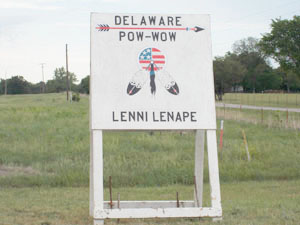 |
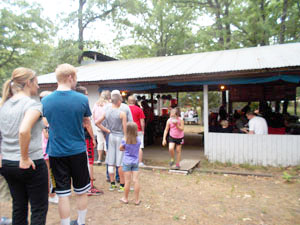 |
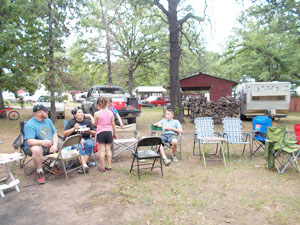 |
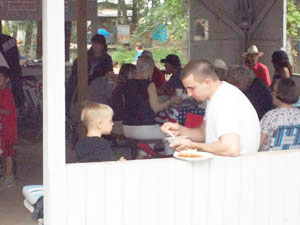 |
 |
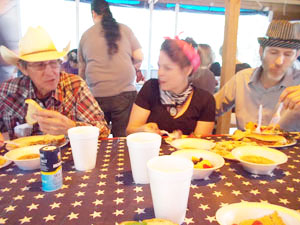 |
 |
 |
 |
 |
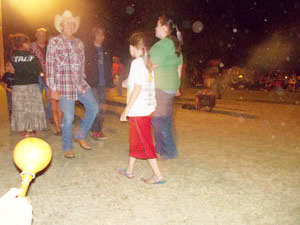 |
 |
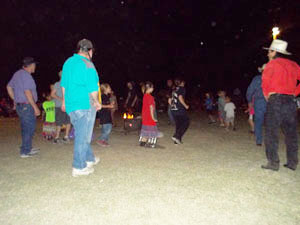 |
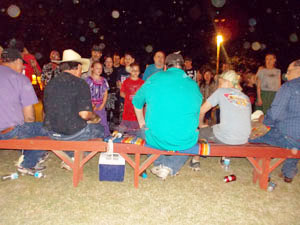 |
Film Explores Delaware Tribe’s History in Indiana
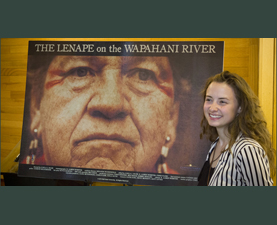
By: Roseanne McKee
On April 12, 2014, Ball State University in Muncie, Indiana, held a special showing of a new documentary about the Delaware Tribe of Indians, for the period in which they made Indiana their home.
The award-winning documentary, prepared by Communications Department students, through filmed re-enactments and interviews, chronicles the forced migration of the Delaware Tribe from their original home in the region now known as southern New York, New Jersey and Delaware through: Pennsylvania, Ohio, Indiana, Missouri, Kansas and present-day Oklahoma.
This 30-minute documentary, entitled Lenape on the Wapahani, explores the historical record of the Delaware Tribe establishing a village near Muncie, Indiana, where Ball State University is located, and the reasons for the Delaware Tribe’s arrival and departure from Indiana.
The group that made the trip to Indiana for the April 12 showing were: Chief of the Delaware Tribe, Paula Pechonick, Tribal Archivist, Anita Davis Mathis and Tribal Manager, Curtis Zunigha. They travelled to Ball State University for the showing and to visit previous village sites along the Wapahani, or White River, in Indiana. Wapahani is the Delaware’s name for the White River. A group of ten Delaware living in Indiana also responded to the invitation for the showing, Mathis said.
“The documentary reconstructs our Indiana history. In 1795 the Greenville Treaty took our ancestors to Indiana and the St. Mary’s Treaty took us out in 1818,” Mathis said.
“The Delaware set up a series of villages starting just below present day Muncie to about the Marion County line above Indianapolis,” Conner Prairie Interactive History Park Historian Tim Crumrin said in the documentary. “There were as many as 12 to 14 villages. There were permanent and seasonal ones,” Crumrin said. “Six stood the test of time. The others were either trading post villages or temporary villages they would set up.”
Mathis said that during the visit to Indiana in April, “they took us to a park where our own village was – where two rivers meet – the White and the Buck River, Tribal Archivist, Anita Mathis, said in an interview May 5. One thing that struck her was that “where the rivers met, there were two different colors,” Mathis said.
During the visit, Zunigha offered a prayer, Mathis said. “He took from his cedar chest and offered tobacco at the site. This is a gift to the land and the spirits. He threw it on the ground facing the east and prayed and then offered some to the water. His prayers were said in English and in Delaware.”
Mathis said she was grateful that Ball State University had provided her with raw interview footage and information to add to the Delaware Tribe’s archives with details about this period. “In 1751 the Delaware moved to Eastern Ohio and in 1795 they moved to Indiana,” Mathis said.
Mathis said that she had learned that her ancestors had “lived very simply. It wasn’t uncommon at all for the eldest to be raised by the grandparents. Normally the first born would be raised by the grandparents and then in turn take care of the grandparents.”
In the documentary Crumrin called the Delaware “possibly the most oft moved group in American history.”
The Europeans first encountered the Delaware in the 1560’s according to Historian Mike Pace, who is Delaware, of the Conner Prairie Interactive History Park. A clash of cultures resulted. “The Europeans believed in amassing wealth and in ownership of land,” Pace explained.
“The tribes here believed not in the ownership of land. The land was for everybody to share in. We did not have a reason to amass wealth…” Pace said. Nonetheless, over time the Delaware were again moved and agreed to accept land in Kansas territory.
“We were the first tribe to sign a treaty with the new U.S. government in 1778,” Mathis said.
“The Delaware moving from their original homeland back East, those moves were precipitated by agreements with European countries or the new United States of America through treaties,” Curtis Zunigha said in the documentary.
After leaving Indiana, the Delaware stopped in Missouri, before settling in Kansas for a time, Mathis said.
“When they left Indiana they came to Missouri, by Springfield for a couple of years and then went into Kansas where they had over two million acres – Kansas City, Leavenworth, Lawrence, Kansas. By 1835 they were all in Kansas, where they stayed until 1867,” Mathis said.
“We got paid in Kansas for our lands and paid the Cherokee for what is now Washington County, [Oklahoma],” she added.
According to the text of the document provided by Mathis, on April 8, 1867, the Delaware signed a Memorandum of Agreement with the Cherokee to pay $1.00 per acre for 160 acres for each man, woman, and child of the Delaware Tribe “for the use of the lands by which to preserve their tribal organization and laws for a total sum of $157,600. In addition, the Delaware paid the sum of $121,824.28 to the Cherokee as a proportional amount of the Cherokee National fund determined by the number of Delawares as compared to the whole number of Cherokee.”
The Cherokee Nation viewed this payment for lands as a lease rather than a land purchase, Mathis explained. Unable to persuade the Bureau of Indian Affairs otherwise, the Delaware Tribe had no reservation as a result.
“We’re a landless tribe except for the land we now have — seven acres in Caney and then the 93 acres in Lawrence, [Kansas]. Some of which is on the original reservation,” Mathis said.
The documentary described the Delaware Tribe as “a persistent people.” With a long history of forced migration, the Delaware, nonetheless, retained their tribal identity.
“Many other tribes did not survive or they’ve had to be absorbed by other tribes to survive. That persistence is because we have an obligation to keep our identity, our language, our culture and tribal identity because it is a gift from the Creator,” Zunigha said in the documentary.
“Wherever they moved, they began to have a relationship with the river, the water that gave them life and sustenance,” Zunigha explained.
In the documentary the Delaware are referred to as Lenape. The Delaware name began being used to describe the Lenape because of their location near the Delaware River, which was named after Lord Dela Warr, Crumrin explained.
“The original land of the Lenape, that ties to all of our creation legends, the first memory of who we are as a people originated in that river valley and all the way to the Atlantic Ocean. Our creation legend says that a great turtle rose from the ocean to create Turtle Island – the North American continent,” Zunigha said.
Mathis is pleased a portion of the Kansas acreage purchased is on land that was part of the Delaware Tribe’s Kansas reservation. The land will provide a base operation in Kansas to provide services to members of the Delaware Tribe and to advance the preservation of their language, culture and lifeways.
Perhaps most important, the purchase of the 93 acres in Kansas by the Delaware Tribe provides a fresh opportunity for something that the Delaware have not had since they left their original home – a place to call their own.
The documentary may be viewed at www.lenapeonthewapahani.org.
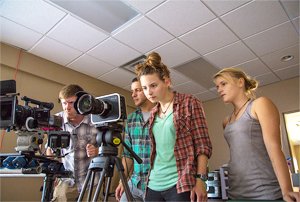 Gaffer Andrew Bultemeier, Cinematographer R. Aaron Webster, Director Kayla Eiler, and 1st Asst Camera Kathie Green prepare for interviews on Bartlesville campus. Gaffer Andrew Bultemeier, Cinematographer R. Aaron Webster, Director Kayla Eiler, and 1st Asst Camera Kathie Green prepare for interviews on Bartlesville campus. |
 Field Audio Specialist Ben Kruis, Gaffer Andrew Bultemeier, 1st Asst Camera Kathie Green, and Director Kayla Eiler. Field Audio Specialist Ben Kruis, Gaffer Andrew Bultemeier, 1st Asst Camera Kathie Green, and Director Kayla Eiler. |
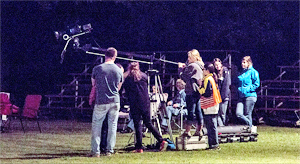 Crew films during Delaware Days, September 2013. Crew films during Delaware Days, September 2013. |
 Curtis Zunigha, Director of Cultural Resources Anita Mathis, and Chief Paula Pechonick answer questions at premiere showing at Ball State University, April 2014. Curtis Zunigha, Director of Cultural Resources Anita Mathis, and Chief Paula Pechonick answer questions at premiere showing at Ball State University, April 2014. |
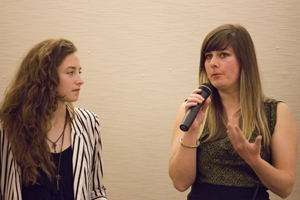 Executive Director Alina Beteringhe answers questions with Kayla Eiler. Executive Director Alina Beteringhe answers questions with Kayla Eiler. |
 Executive Producer Kelli Huth talks with Tribal Manager Curtis Zunigha. Executive Producer Kelli Huth talks with Tribal Manager Curtis Zunigha. |
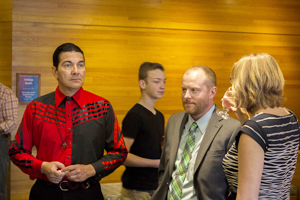 Curtis Zunigha with executive producers Chris Flook and Kelli Huth. Curtis Zunigha with executive producers Chris Flook and Kelli Huth. |
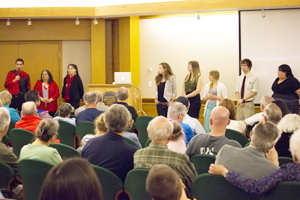 Filmmakers (right) and tribal officials answer questions at the premiere at Ball State University. Filmmakers (right) and tribal officials answer questions at the premiere at Ball State University. |
The Delaware Tribe’s Traditional Clothing Sewing Circle

About three months ago, several members of the Delaware Tribe decided to begin meeting on a weekly basis to work on their own sewing and beading projects.
“With the pow wow coming, we thought it would be a good idea,” Delaware Councilwoman Janifer “Jan” Brown explained, referring to the Delaware Tribe’s upcoming 50th Annual Pow Wow, scheduled to take place May 23 – 25 at the Fred Fall-Leaf Memorial Campgrounds near Copan.
Chief Paula Pechonick said, “I needed time to get projects finished. Long ago my grandmother would get together with other Delaware women to sew.”
The traditional clothing sewing circle, which meets on Tuesdays 5:30 – 7:30 p.m. in the Delaware Community Center’s Forsythe Hall, is informal and social in nature.
“We wanted to have more of a sewing circle. We had projects to get done and we knew they’d be more likely to get done if we did that,” Delaware Councilwoman Jenifer Pechonick explained.
Other benefits of the gathering are encouragement and expertise offered by the more experienced participants to those just starting out.
Chief Pechonick explained the difference between appliqué and ribbon work: “[f]or ribbon work, you cut down through the layers, but appliqué you stack on top of one another.” She described a nine-layer skirt she had constructed using ribbon work to create a tulip design.
Brown pointed to Chief and said, “She’s our expert. I’ve been studying under her for 25 years.”
Anna Pechonick, age ten, said, “She made my clothes and my mom’s clothes.”
Jodi Anaya, who said she joined the class at the invitation of her Aunt Bess said: “I’m a beginner. I joined to learn more about my heritage.”
Brown said: “Your moccasin is so good. You’re gifted.”
Connie Collier agreed, admiring Jodi’s moccasin beadwork.
Collier, who also sews traditional clothing for others, was seated at the table with the others. Collier was busy making a shawl for Anna’s giveaway. Chief explained that Anna Pechonick is Head Girl Dancer at the upcoming pow wow and that it is customary for Head Girl Dancer to give gifts. The gifts will be given to the people on the pow wow committee, the staff and privately to others.
Another custom is for the Delaware to take gifts to the arena where the pow wow will take place and leave them at various spots. Sometimes, the announcer will specify that the gifts are for the elders or the women. Those within the stated category, who feel led, will go and get one of the gifts, Collier said.
“Candy will be handed out to the children also,” Collier explained.
Anaya’s Aunt, Bess Marler, said, “I’ve been doing beadwork since I was a little kid. My mom taught me when I was small. She went to Wyndotte Indian School. But I just started sewing traditional clothes three months ago. I made my moccasins and then the dress.”
Marler explained that previously she had made bracelets and necklaces by bead-weaving. Beading the moccasins she had made was similar to the bead work she had done previously. For this project the beadwork was placed on fabric and then sewn to the moccasin.
“My granddaughter Katie is usually here too. She is 16.”
Marler described the traditional clothing she had made for her: “Katie’s shawl has a hummingbird and trumpet flowers.” She explained the significance: “The trumpets are like my grandmother’s trumpet vines and Katie’s my little hummingbird.”
Regarding her attendance Anna Pechonick said, “I started this year, but I have watched my grandmother and my mom for years. My grandmother gave me a sewing machine when I was eight and I used swatches to see what kind of design I could make.”
This is not the only sewing group which meets at the Community Center, Another group, specifically for the Native American children, provides more formal instruction.
“On Thursday nights there’s a group that meets that beads and I’ve seen them make earrings. They teach them how to stomp dance too,” Anna Pechonick said.
More information about the Thursday night class, called “Lenapeowsi,” can be found on their Facebook page, Jenifer Pechonick said.
“We support the use of the Community Center,” Jenifer said. “This is a multi-generational facility with a child care center on one side and the elder nutrition program and offices on the other.”
For more information about the activities at the Delaware Community Center, visit the website at: www.delawaretribe.org or call 918-337-6590. For more about the upcoming pow wow call Lu Ann Hainline at 918-338-9907.
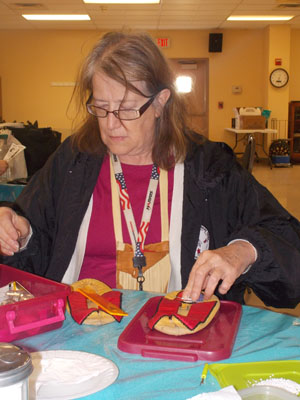 Delaware Councilwoman Janifer “Jan” Brown doing moccasin beadwork at the Delaware’s traditional clothing sewing circle held on Tuesday evenings 5:30 – 7:30 at the Delaware Tribe’s Community Center in Forsythe Hall. Delaware Councilwoman Janifer “Jan” Brown doing moccasin beadwork at the Delaware’s traditional clothing sewing circle held on Tuesday evenings 5:30 – 7:30 at the Delaware Tribe’s Community Center in Forsythe Hall. |
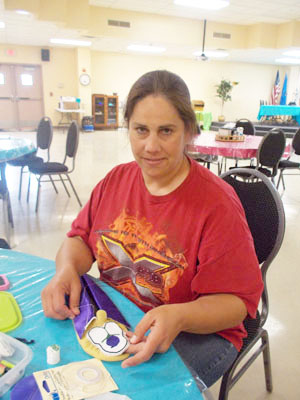 Jodi Anaya shows her moccasin with beadwork she is working on at the Delaware’s traditional clothing sewing circle. Jodi Anaya shows her moccasin with beadwork she is working on at the Delaware’s traditional clothing sewing circle. |
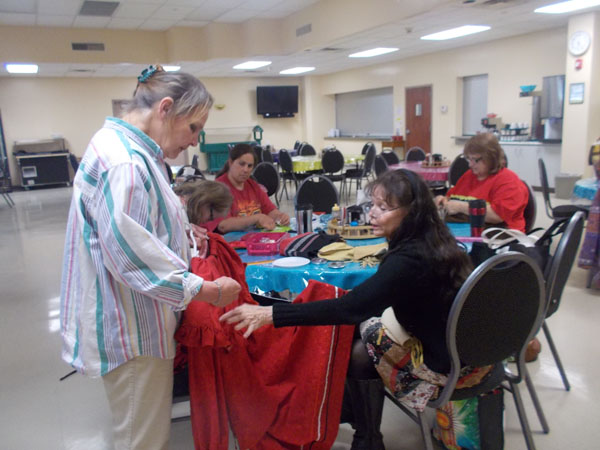 (L-R) Bess Marler shows Delaware Chief Paula Pechonick the dress she is sewing at the Delaware’s traditional clothing sewing circle. (L-R) Bess Marler shows Delaware Chief Paula Pechonick the dress she is sewing at the Delaware’s traditional clothing sewing circle. |
|
Delaware Tribe of Indians Online Gift Shop Open for Business!
We are excited to announce that the online gift shop for the Delaware Tribe of Indians is now up and running! The same outstanding collection of Delaware merchandise available at the Tribal Headquarters in Bartlesville is now available for those of us who want to show off our Lenape heritage, but are unable to make it out to Oklahoma. We have everything from pocket Lenape dictionaries, to apparel featuring the official tribal seal, to beadwork, to books about Delaware history, and much, much more! We offer shipping throughout the United States as well as free in-person pickup in Bartlesville. We are also offering the option to pick up orders for free at the annual Pow-Wow each year in the Bartlesville area on Memorial Day weekend. All proceeds go towards expanding and improving the Cultural Resources Department of the Delaware Tribe of Indians as we work towards our ultimate goal of creating a museum for Delaware culture and history.
You can find the online gift shop at https://www.delawaretribe.org/shop or by clicking on the Gift Shop button at the bottom of the Delaware Tribe of Indians home page at https://www.delawaretribe.org. Check back often as we will be adding some exciting new products over the next few months.
All online payments are processed through PayPal. PayPal registration is free and available at http://www.paypal.com, or you can use a credit or debit card.
Everything available online is also available at the Gift Shop located in the Social Services building at the Tribal Headquarters at 170 NE Barbara, Bartlesville, OK 74006. Visitors to the Gift Shop will be able to explore the Tribal Archives, as well as have first access to new products as they are added to the online store. The Gift Shop in Bartlesville accepts cash, checks, and most major credit/debit cards. The Gift Shop hours are 9:00 AM–5:00 PM Monday–Thursday and 10:00 AM–2:00 PM on Friday.
Questions, comments, and suggestions are welcome! You can reach us at shop@delawaretribe.org. If you are a Delaware artisan, who wishes to have your products sold through the Delaware Gift Shop, contact Anita Mathis at amathis@delawaretribe.org.

 D5 Creation
D5 Creation